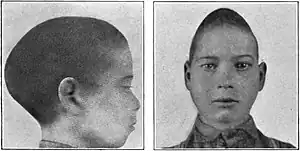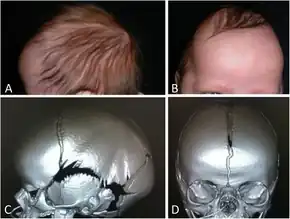Scaphocephaly
| Scaphocephaly | |
|---|---|
| Other names: Sagittal craniosynostosis | |
 | |
| Boy with Scaphocephaly | |
| Pronunciation |
|
Scaphocephaly, also known as sagittal craniosynostosis, is a type of cephalic disorder which occurs when there is a premature fusion of the sagittal suture. Premature closure results in limited lateral expansion of the skull resulting in a characteristic long, narrow head.[1] The skull base is typically spared.[2]
Scaphocephaly is the most common of the craniosynostosis conditions and accounts for approximately 50% of all craniosynostosis.[3] It is most commonly idiopathic (non-syndromic).
Classification
Scaphocephaly is classified into 3 types, depending on morphology and position and suture closure:[4]
- Sphenocephaly ("wedge-shaped", most common)
- Clinocephaly (camelback-shaped)
- Leptocephaly ("thin head", least common); this occurs when the metopic suture is also fused
.jpg.webp) Sphenocephaly
Sphenocephaly Leptocephaly
Leptocephaly
Cause
Non-syndromic
The underlying cause of the non-syndromic form is unknown. Over 100 mutations have been associated, including mutations in the FGFR genes.[5] Several potential risk factors have been identified for craniosynostosis include:[6]
- Advanced maternal age
- White maternal race
- Maternal smoking
- Male infant
- Certain paternal occupations (e.g. agriculture, forestry, repairmen) [7]
Syndromic
Involvement of the sagittal suture may occur as a result of syndromic craniosynostosis syndromes, although involvement of other sutures in addition to the sagittal suture is likely.[8] Examples include:
- Crouzon Syndrome: bilateral coronal suture fusion with anterior and posterior of skull shortness, flat cheek bones and a flat nose.[9]
- Apert Syndrome: an abnormal skull shape, small upper jaw, and fusion of the fingers and toes.[10]
Diagnosis

Diagnosis of scaphocephaly is with physical exam, which may show characteristic features such as an elongated head in the anterior-posterior dimension, narrow head in the lateral dimension, and bony ridge at the vertex.[11]
Further evaluation with imaging may also be performed. Ultrasound may be used to detect fusion of the suture. CT scans may also be used to help with surgical planning and to diagnose associated hydrocephalus, which has been found to be present in 44% of cases in one study.[12] A measure of cephalic index may also be reduced, however the reliability of measurements may not be a reliable measure.[13]
Treatment
This condition can be corrected by surgery if the child is young enough, typically within the first 3–6 months.[11] The goal of treatment is to correct intracranial pressure and repair bony deformities.[14] The decision to treat is multifactorial and should be performed at a center with an experienced craniofacial team.[15] In addition to the primary craniofacial surgeon, team members may include audiologists, dentists, otolaryngologists, neurosurgeons, plastic surgeons, and other supporting members.[15]
Surgery is generally aimed at removal of the fused sagittal suture to allow for lateral expansion of the skull. Surgical options include:[11]
- Endoscopic strip craniectomy: Minimally invasive removal of the fused suture. Following surgery, patients typically wear a helmet to help shape the head. Helmets are usually worn for 3–12 months.[16]
- Open cranial vault remodeling: Open surgical removal of the fused sagittal suture and re-shaping of the skull, generally with resorbable plates.[17]
- Spring cranioplasty: Combination of an endoscopic strip craniectomy with placement of springs which provide continuous force for re-shaping the skull.[18]
Terminology
The term, from Greek skaphe meaning 'light boat or skiff' and kephale meaning 'head', describes a specific shape of a long narrow head[19] that resembles a boat.
See also
References
- ↑ Sandoval, Jose I.; De Jesus, Orlando (2022), "Scaphocephaly", StatPearls, Treasure Island (FL): StatPearls Publishing, PMID 33620830, archived from the original on 2023-02-21, retrieved 2023-01-11
- ↑ Márquez, Juan Camilo; Herazo Bustos, Cherina; Wagner, Matthias W. (2021-03-01). "Craniosynostosis: Understanding the Misshaped Head". RadioGraphics. 41 (2): E45–E46. doi:10.1148/rg.2021200127. ISSN 0271-5333. PMID 33646908. S2CID 232090523. Archived from the original on 2022-12-31. Retrieved 2023-02-21.
- ↑ "Pediatric Sagittal Synostosis | Doernbecher Children's Hospital | OHSU". www.ohsu.edu. Archived from the original on 2023-01-11. Retrieved 2023-01-11.
- ↑ Vinchon, Matthieu; Pellerin, Philippe; Guerreschi, Pierre; Baroncini, Marc; Dhellemmes, Patrick (2012). "Atypical scaphocephaly: a review". Child's Nervous System. 28 (9): 1319–1325. doi:10.1007/s00381-012-1807-8. ISSN 0256-7040. PMID 22872243. S2CID 24212027. Archived from the original on 2023-02-21. Retrieved 2023-02-21.
- ↑ Ye, Xiaoqian; Guilmatre, Audrey; Reva, Boris; Peter, Inga; Heuzé, Yann; Richtsmeier, Joan T.; Fox, Deborah J.; Goedken, Rhinda J.; Jabs, Ethylin Wang; Romitti, Paul A. (2016-03-01). "Mutation Screening of Candidate Genes in Patients with Nonsyndromic Sagittal Craniosynostosis". Plastic and Reconstructive Surgery. 137 (3): 952–961. doi:10.1097/01.prs.0000479978.75545.ee. ISSN 1529-4242. PMC 4770826. PMID 26910679.
- ↑ Kabbani, Haidar; Raghuveer, Talkad S. (2004-06-15). "Craniosynostosis". American Family Physician. 69 (12): 2863–2870. PMID 15222651. Archived from the original on 2023-01-03. Retrieved 2023-02-21.
- ↑ Bradley, C. M.; Alderman, B. W.; Williams, M. A.; Checkoway, H.; Fernbach, S. K.; Greene, C.; Bigelow, P. L.; Reif, J. S. (1995-05-01). "Parental occupations as risk factors for craniosynostosis in offspring". Epidemiology. 6 (3): 306–310. doi:10.1097/00001648-199505000-00020. ISSN 1044-3983. PMID 7619941. S2CID 24625014. Archived from the original on 2023-01-03. Retrieved 2023-02-21.
- ↑ Sawh-Martinez, Rajendra; Steinbacher, Derek M. (2019). "Syndromic Craniosynostosis". Clinics in Plastic Surgery. 46 (2): 141–155. doi:10.1016/j.cps.2018.11.009. ISSN 1558-0504. PMID 30851747. S2CID 73725626. Archived from the original on 2023-01-04. Retrieved 2023-02-21.
- ↑ Conrady, Christopher D.; Patel, Bhupendra C. (2022), "Crouzon Syndrome", StatPearls, Treasure Island (FL): StatPearls Publishing, PMID 30085540, archived from the original on 2022-09-27, retrieved 2023-01-11
- ↑ Conrady, Christopher D.; Patel, Bhupendra C.; Sharma, Sandeep (2022), "Apert Syndrome", StatPearls, Treasure Island (FL): StatPearls Publishing, PMID 30085535, archived from the original on 2023-02-07, retrieved 2023-01-11
- 1 2 3 Sandoval, Jose I.; De Jesus, Orlando (2022), "Scaphocephaly", StatPearls, Treasure Island (FL): StatPearls Publishing, PMID 33620830, archived from the original on 2023-02-21, retrieved 2023-01-03
- ↑ Wall, Steven A.; Thomas, Gregory P. L.; Johnson, David; Byren, Jo C.; Jayamohan, Jayaratnam; Magdum, Shailendra A.; McAuley, David J.; Richards, Peter G. (2014-12-01). "The preoperative incidence of raised intracranial pressure in nonsyndromic sagittal craniosynostosis is underestimated in the literature". Journal of Neurosurgery. Pediatrics. 14 (6): 674–681. doi:10.3171/2014.8.PEDS1425. ISSN 1933-0715. PMID 25259602. Archived from the original on 2023-01-04. Retrieved 2023-02-21.
- ↑ Fearon, Jeffrey A.; Ditthakasem, Kanlaya; Herbert, Morley; Kolar, John (2017-07-01). "An Appraisal of the Cephalic Index in Sagittal Craniosynostosis, and the Unseen Third Dimension". Plastic and Reconstructive Surgery. 140 (1): 138–145. doi:10.1097/PRS.0000000000003422. ISSN 1529-4242. PMID 28654600. S2CID 31253312. Archived from the original on 2023-01-04. Retrieved 2023-02-21.
- ↑ Ciurea, AV; Toader, C; Mihalache, C (2011-11-14). "Actual concepts in scaphocephaly". Journal of Medicine and Life. 4 (4): 424–431. ISSN 1844-122X. PMC 3227159. PMID 22514579.
- 1 2 Buchanan, Edward P; Xue, Yunfeng; Xue, Amy S; Olshinka, Asaf; Lam, Sandi (2017-07-06). "Multidisciplinary care of craniosynostosis". Journal of Multidisciplinary Healthcare. 10: 263–270. doi:10.2147/JMDH.S100248. ISSN 1178-2390. PMC 5505551. PMID 28740400.
- ↑ "Endoscopic Strip Craniectomy - Seattle Children's". Seattle Children’s Hospital. Archived from the original on 2023-01-04. Retrieved 2023-01-04.
- ↑ Panchal, Jayesh; Uttchin, Venus (2003-05-01). "Management of craniosynostosis". Plastic and Reconstructive Surgery. 111 (6): 2032–2048, quiz 2049. doi:10.1097/01.PRS.0000056839.94034.47. ISSN 0032-1052. PMID 12711969. Archived from the original on 2023-02-21. Retrieved 2023-02-21.
- ↑ "Spring Assisted Cranioplasty | UPMC Children's Hospital". Children's Hospital of Pittsburgh. Archived from the original on 2023-01-04. Retrieved 2023-01-04.
- ↑ "scaphocephaly" at Dorland's Medical Dictionary
External links
| Classification |
|---|